Lattice and MediaTek to Collaborate On Reference Smartphones For SuperMHL over USB-C
by Anton Shilov on March 15, 2016 6:45 PM EST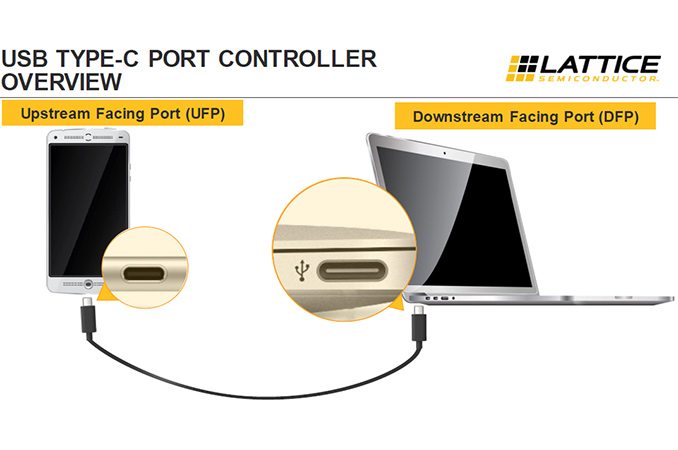
Lattice Semiconductor and MediaTek have joined forces to create reference smartphones with 4K video outputs using USB Type-C connectors and cables. The outputs will use the superMHL technology and will thus be compatible with various other superMHL devices such as TVs. The companies have already built a reference phone that supports a superMHL output over USB-C using previously announced chips from Lattice and hope that makers of smartphones will embrace the solution.
The USB Type-C technology and connectors are rapidly gaining traction across many industries. A number of modern notebooks, mobile devices and even desktops come with USB type-C ports. A good thing about USB-C is that it can be used to transfer alt mode data using a variety of protocols, including DisplayPort, Thunderbolt 3 and superMHL. Lattice (which acquired Silicon Image, a major developer of the MHL technology, about a year ago) clearly wants to capitalize on its expertise in the field of MHL and USB technologies by offering a reference implementation of single-lane superMHL over USB-C cables and connectors.
The simplified single-lane implementation of the superMHL used here for phones supports transmission of video in 4K (3840x2160) resolution with 60 fps over USB-C or even traditional MHL cables.
| USB Type-C Alt Mode Display Standard Comparison | ||||
| superMHL | DisplayPort 1.3 | |||
| Resoluion | 4Kp60, 4:4:4 @ 24bit | 4Kp60, 4:4:4 @ 24bit | ||
| Type-C Lanes Required | 1 | 2 | ||
| Image Compression | "Visually Lossless" (Lossy) | No Compression | ||
| TV Interface | superMHL-over-HDMI (Passive) HDMI (Active Conversion) |
HDMI (Active Conversion) | ||
| Power Charging | USB-PD or MHL (legacy) | USB-PD | ||
The superMHL over USB-C reference implementation by Lattice and MediaTek involves the Helio X20 system-on-chip (two ARM Cortex-A72, four Cortex-A53 at 2 GHz, four Cortex-A53 at 1.4 GHz, ARM Mali T880 MP4 graphics core, dual-channel LPDDR3 memory controller), the Sil8348 MHL transmitter as well as the Sil7033 port controller (which sets up MHL alt mode on USB-C and supports power data objects, which are needed to charge the phone). The superMHL implementation by Lattice and MediaTek supports best of both technologies’ worlds: 10 Gbps USB 3.1 transfer rate, 4Kp30 video, power delivery (for up to 100W of power), ability to connect to TVs with MHL using appropriate adapters. What is notable is that thanks the to the Sil7033 chip, simultaneous MHL and USB 3.1 connectivity is also supported. Lattice also offers Sil7013 and the Sil9396 port controllers for docks and accessories to establish MHL alt mode and convert MHL to HDMI transmission respectively.
Update on March 24, 2016. Even though single-lane superMHL supports 4Kp60 (4:4:4 @ 24bit) video, the implementation developed by MediaTek and Lattice only supports 4Kp30. MediaTek opted for lower power and only wanted to drive 4Kp30 through the USB Type-C connector, which is why it selected the SiI8348 for this particular implementation. In a bid to support 4Kp30 over a single superMHL late, Lattice’s SiI8630 should be used.
The creation of these reference devices is the latest salvo in the ongoing war Lattice is striking over the future of video out for mobile devices. MHL was decently common in previous generation devices, however with the switch to USB Type-C ports and the creation of alt modes, there is opportunity to start anew. Practically speaking, this is a war between superMHL and DisplayPort, which are the two major video out alt modes.
One thing that will be crucial for enablement of 4K outputs using USB-C interconnection are quality USB Type-C cables. It is not a secret that there are cheap USB 3.1 Type-C cables that do not work as advertised and simply lack conductors, which can be repurposed. Such cables will not be able to support 4K output using USB-C. Cheap USB type-C cables that do not comply with standards are an industry-wide problem. If today many people may simply not notice issues with them because they are only used for data transmission with USB 2.0 hosts, in the coming years the problem will get much worse.
Finally, Lattice and MediaTek did not reveal whether their UHD output over USB-C reference platform has so far been adopted by any makers of smartphones.
Source: Lattice


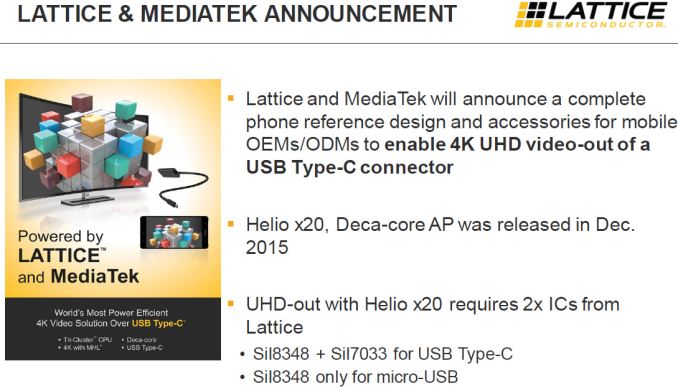
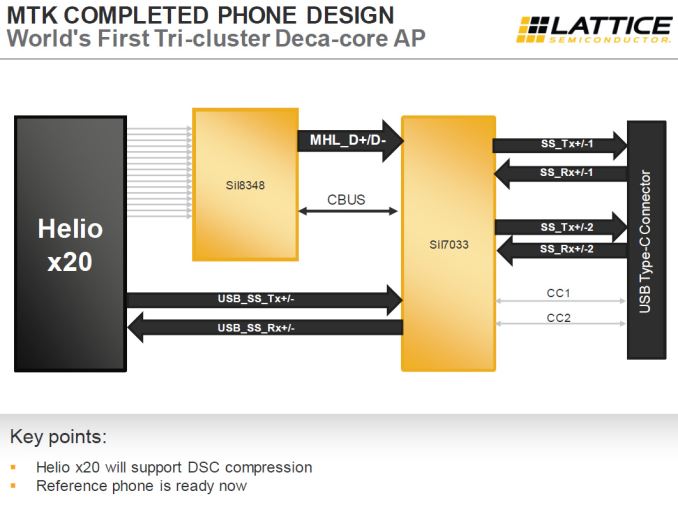
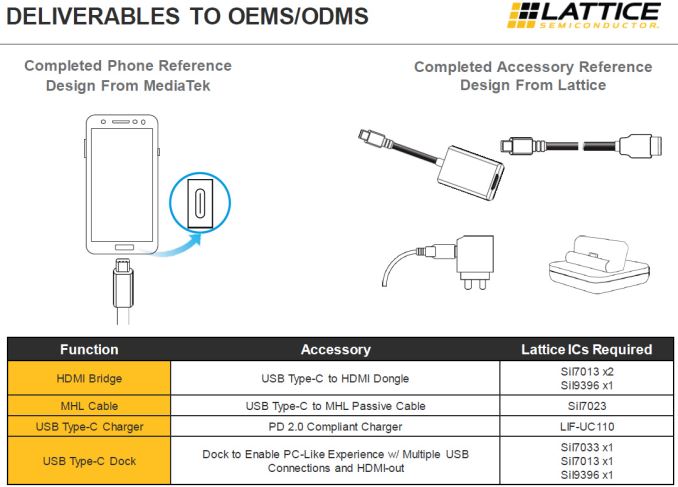
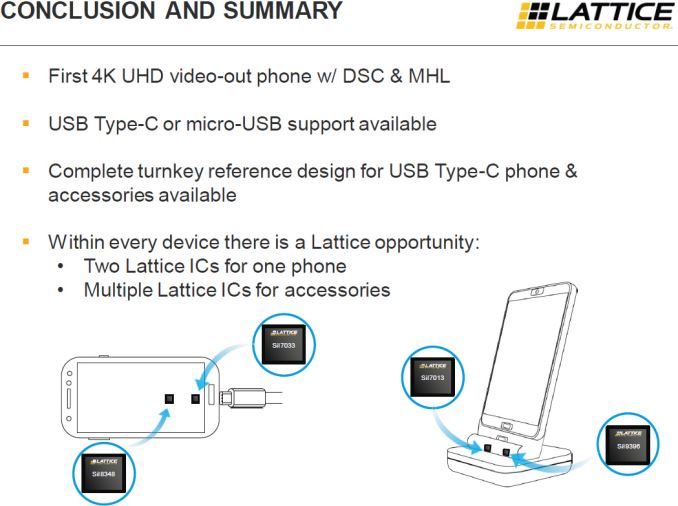














10 Comments
View All Comments
Valantar - Tuesday, March 15, 2016 - link
Isn't a lot of the point of USB alt modes that whatever conversion is needed is done at the end points and in/through the USB controllers? The TB3 controller has HDMI and DP processing built in, from what I understand. And having two competing (non-compatible) standards requiring separate ICs in phones is a problem. If they could be integrated, and the end point (TV, lapdock, whatever) did the decoding, it wouldn't be a problem. But for now, it just seems like another case of adding cost and compatibility issues that in the end only harm end users.I was excited about SuperMHL when it was announced, but right now it seems unnecessary given the development rate and versatility of DisplayPort. And honestly, the last thing the tech world needs is yet another proprietary connector.
abdullah_lattice - Wednesday, March 16, 2016 - link
Hi Valantar, you are correct. The point of USB Alt Modes is to have the negotiation and link setup handled by each end point (DFP/UFP). However, this negotiation has not been fully integrated into USB 3/2 controllers yet since USB Type-C is a new standard. In the mobile phone market, it doesn’t matter if DisplayPort, ThunderBolt, or MHL Alt Modes are used; a separate IC will be needed to drive each signal today. This separate IC will interface between the Application Processor and the USB Type-C connector pins. Adding ThunderBolt into a phone may be difficult due to space, power, and cost constraints, so DP and MHL are both viable alternatives. This article discusses a reference design that chose MHL for UHD video-out due to the low power consumption of the video transmitter and large MHL ecosystem of more than 900 million products on the market today. This will allow MHL-enabled phones to quickly and easily connect to legacy displays on the market that already support MHL. If DP Alt Mode were selected, a similar architecture would be needed (USB Type-C Alt Mode port controller + DisplayPort video transmitter). So cost/complexity is similar for DP Alt Mode and MHL Alt Mode.Just to clarify, the connector using MHL Alt Mode will not be a proprietary connector. It will be the standard USB Type-C connector with a standardized Alternate Mode.
--Abdullah Raouf, Senior Product Marketing Manager, Lattice Semiconductor
Valantar - Friday, March 18, 2016 - link
That's a reasonable argument, especially considering backwards compatibility with current MHL enabled displays. And, of course, Thunderbolt in phones isn't exactly an option. However, I'm wondering if you are in any way working to implement compatibility so that these devices will also work without adapters with DP-enabled displays, for example? After all, DP is royalty-free, and locking users into choosing between competing standards is never a good idea. Firewire is a good example of this - a good technology that had limited adoption among users with very specific needs, and none at all outside of these users.The ideal situation for any end-user would be for their device to be able to connect to any accessory, regardless of standard. This becomes especially important when different standards use the same connector - imagine the confusion of an average user trying to connect their new SuperMHL over USB C-enabled phone to a monitor, TV or docking station (like the one MS has for their new Lumias) that uses DP over USB-C. Confusion and anger would be the consequence. Allowing for limited DP compatibility (say, a single lane, giving 1080p (I think) and an accompanying pop-up on the phone alerting the user of power savings and better image quality if used with an adapter or SMHL-compatible display. That'd be a win-win situation for you.
If your aim is to establish a new standard, technical superiority really isn't enough. Ease of use and broad compatibility is more important to end users - just look at how HDMI is still the dominant standard for video connectors, even though DP has been technically superior for ages. And _all_ DP devices can output HDMI with a simple, passive adapter. Yet they're still a tiny fraction of the market.
CK1234567 - Friday, March 18, 2016 - link
When Samsung pull the plug of MHL since S6, which means over the years of MHL deployment, usage cases is extremely low to justify the additional BOM cost. I am not saying DP has a higher usage case but overall using a mobile device + wire connecting to a display is not what the market ask for. Wire connectivity are meant for stationary devices...Valantar - Sunday, March 20, 2016 - link
Saying that it's not what the majority of the market is looking for as that it shouldn't be possible are not the same thing. At all. Sure, wireless transfer is great for streaming and stuff like that - but it's laggy, has visible compression artifacts, uses even more power, and is utterly useless for things like games. Not to mention that streaming 4k wirelessly is at best a pipe dream at this point.With Android finally gaining usable multitasking with N, this is far more relevant, especially in the tablet space. No android tablet will ever compete with the Surface if it lacks video output. This still needs improvements, though - - the ability to draw to separate monitors at separate resolutions, for one. And more options than just mirroring phone display content.
Also, I for one think Continuum is a very viable concept - MS just needs to polish W10 a bit and get more device makers on board. Which would again require a wired video output.
ericloewe - Wednesday, March 16, 2016 - link
This is bad for pretty much anyone. It offers no advantages over DisplayPort (which is a first-class citizen in the USB C alt mode world), besides using less bandwidth. Given the fact that most phones are still using USB 2.0 anyway (which does coexist with DisplayPort over USB Type C in all conditions), it just serves to create unnecessary confusion.serendip - Wednesday, March 16, 2016 - link
If it's a war between SuperMHL and DisplayPort, I'd expect the latter to win. It's already prevalent in laptops and hopefully it'll be cheap to implement on smartphones, unlike HDMI which appeared on flagships in 2012 and then disappeared.As for MediaTek, I hope they don't win this competition. They're right b*st*rds for trying to weasel out of GPL obligations and not releasing Android kernel sources to the public.
Nintendo Maniac 64 - Wednesday, March 16, 2016 - link
Now consider that SlimPort already exists which is basically mobile DisplayPort.aIIergen - Wednesday, March 16, 2016 - link
Anton, Silicon Image and ex-Silicon Image Lattice products tend to be written Sil, but it's SiI actually.(Search for sil and sii on the press release page you linked.)
CK1234567 - Friday, March 18, 2016 - link
What's the point of having MHL when your SoC can do DP already? Extra 2 chips in the ref design when you only need 1 (handling the USB alt mode) for native 4k60 via DP is a no brainer. Any future monitor/TV that has a USB-C connector will be able to handle DP. Adding a MHL burden the overall cost of the eco-system. What we should see in the future is to have mobile SoC be able to bring out PCIe interface via USB-C (Thunderbolt) for external connectivity